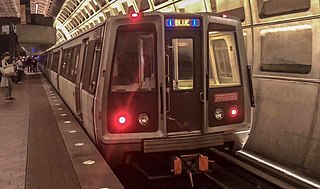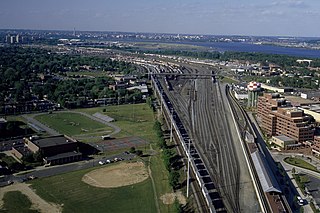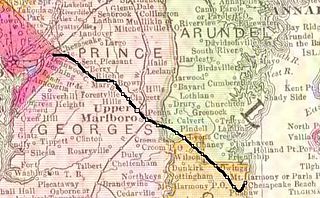
The Baltimore and Ohio Railroad was the first common carrier railroad and the oldest railroad in the United States. It operated as B&O from 1830 until 1987, when it was merged into the Chessie System; its lines are today controlled by CSX Transportation.

The Maryland Area Rail Commuter (MARC) is a commuter rail system in the Washington–Baltimore area. MARC is administered by the Maryland Transit Administration (MTA) and operated under contract by Alstom and Amtrak on track owned by CSX Transportation (CSXT) and Amtrak. In 2023, the system had a ridership of 3,860,600, or about 14,000 per weekday as of the second quarter of 2024, less than pre-COVID-19 pandemic weekday ridership of 40,000.

The Blue Line is a rapid transit line of the Washington Metro system, consisting of 28 stations in Fairfax County, Alexandria and Arlington, Virginia; Washington, D.C.; and Prince George's County, Maryland, United States. The Blue Line runs from Franconia–Springfield to Downtown Largo. The line shares track with the Orange Line for 13 stations, the Silver Line for 18, and the Yellow Line for 7. Only 3 stations are exclusive to the Blue Line.

The Richmond, Fredericksburg, and Potomac Railroad was a railroad connecting Richmond, Virginia, to Washington, D.C. The track is now the RF&P Subdivision of the CSX Transportation system; the original corporation is no longer a railroad company.

The Western Maryland Railway was an American Class I railroad (1852–1983) that operated in Maryland, West Virginia, and Pennsylvania. It was primarily a coal hauling and freight railroad, with a small passenger train operation.

The Capital Subdivision is a railroad line owned and operated by CSX Transportation in the U.S. state of Maryland and the District of Columbia. The line runs from near Baltimore, Maryland, southwest to Washington, D.C., along the former Baltimore and Ohio Rail Road (B&O) Washington Branch. The subdivision's Alexandria Extension provides a connection to Virginia and points south.

The Baltimore and Potomac Railroad (B&P) operated from Baltimore, Maryland, southwest to Washington, D.C., from 1872 to 1902. Owned and operated by the Pennsylvania Railroad, it was the second railroad company to connect the nation's capital to the Northeastern U.S., and competed with the older Baltimore and Ohio Railroad.

Potomac Yard is a neighborhood in Northern Virginia that straddles southeastern Arlington County and northeastern Alexandria, Virginia, located principally in the area between U.S. Route 1 and the Washington Metro Blue Line /Yellow Line tracks, or the George Washington Memorial Parkway, depending on the definition used. The area was home to what was once one of the busiest rail yards on the Eastern Seaboard of the United States. The "Potomac Yard" name is also used to refer to several developments in the area, especially the Potomac Yard Center power center and a Washington Metro station.

The Washington, Brandywine & Point Lookout Railroad (WB&PL) was an American railroad that operated in southern Maryland and Washington, D.C., from 1918 to 1942; but it and other, shorter-lived entities used the same right-of-way from 1883 to 1965. The single-track line connected Mechanicsville, Maryland to the Pennsylvania Railroad in Brandywine. Most of the rail was constructed by the Southern Maryland Railroad, which also built a section of track in East Washington that was intended to connect with this line but never did. The WB&PL was later acquired by the Navy, which extended the line to Cedar Point and the Patuxent Naval Air Station. In 1962, the Pennsylvania Railroad constructed a spur from Hughesville, Maryland to the Chalk Point Generating Station. During the 1960s and 1970s, the section from Hughesville to Cedar Point was abandoned and removed, and this area has since been repurposed for a highway, roads, a utility corridor, and a bike trail. The section from Brandywine to Hughesville, extending to Chalk Point, remains in use, though infrequently, as the plant ceased using coal in 2022.

The Harrisburg Subdivision is a railroad line owned by CSX Transportation in Pennsylvania. The line is located in Philadelphia, and connects Greenwich Yard and the Philadelphia Subdivision with the Trenton Subdivision along a former Pennsylvania Railroad line. Much of the Harrisburg Subdivision is the High Line' or West Philadelphia Elevated along 31st Street over the 30th Street Station area.

The Metropolitan Subdivision is a railroad line owned and operated by CSX Transportation in Washington, D.C. and Maryland.The 53-mile line runs from Washington, D.C., northwest to Weverton, Maryland, along the former Metropolitan Branch of the Baltimore and Ohio Railroad.

The Pope's Creek Subdivision is a CSX Transportation railroad line in Maryland, running from Bowie the Morgantown Generating Station in Morgantown, Maryland. The Herbert Subdivision to the Chalk Point Generating Station connects to it at Brandywine and the Indian Head-White Plains railroad used to connect to it at White Plains. Its name comes from Pope's Creek in Newburg, MD to where it originally ran.

The Fredericksburg Line is a commuter rail service operated by Virginia Railway Express between Washington, D.C., and Olive, Virginia. Virginia Railway Express operates 8 weekday trains, and Amtrak trains serve a few of the stations on the line. Trackage is owned by CSX as part of their RF&P Subdivision.

The Anacostia Railroad Bridge is a vertical lift railroad bridge crossing the Anacostia River in Washington, D.C., United States. The bridge is owned by CSX Transportation.

The Virginia Avenue Tunnel is a pair of railroad tunnels in Washington, D.C. owned by CSX Transportation. It is part of the CSX RF&P Subdivision and serves freight trains along the eastern seaboard routes, providing a bypass around Union Station.

The Chesapeake Beach Railway (CBR), now defunct, was an American railroad of southern Maryland and Washington, D.C., built in the 19th century. The CBR ran 27.629 miles from Washington, D.C., on tracks laid by the Southern Maryland Railroad and its own single track through Maryland farm country to a resort at Chesapeake Beach. The construction of the railway was overseen by Otto Mears, a Colorado railroad builder, who planned a shoreline resort with railroad service from Washington and Baltimore. It served Washington and Chesapeake Beach for almost 35 years, but closed amid the Great Depression and the rise of the automobile. The last train left the station on April 15, 1935. Parts of the right-of-way are now used for roads and a future rail trail.
The Landover Subdivision is a railroad line owned and operated by CSX Transportation. It runs from the Anacostia section of Washington, D.C., to Landover, Maryland, serving as a freight train bypass of Washington Union Station.

The RF&P Subdivision is a railroad line operated by CSX Transportation and jointly owned by CSX and Virginia. It runs from Washington, D.C., to Richmond, Virginia, over lines previously owned by the Pennsylvania Railroad and the Richmond, Fredericksburg and Potomac Railroad. The line's name pays homage to that railroad, which was a predecessor to the CSX.

Long Bridge is the common name used for three successive bridges connecting Washington, D.C., to Arlington, Virginia, over the Potomac River. The first was built in 1808 for foot, horse and stagecoach traffic, and bridges in the vicinity were repaired and replaced several times in the 19th century. The current bridge was built in 1904 and substantially modified in 1942. It has only been used for railroad traffic and is owned by CSX Transportation.

The Washington District is a Norfolk Southern Railway line in the U.S. state of Virginia that connects Alexandria and Lynchburg. Most of the line was built from 1850 to 1860 by the Orange and Alexandria Railroad, while a small portion in the center opened in 1880 as the Charlottesville and Rapidan Railroad. Today, the line is mainly used for freight service, but Amtrak's Crescent, Cardinal and Northeast Regional passenger services use all or part of the line, and the Virginia Railway Express Manassas Line commuter service uses the northernmost portion of the line.



















